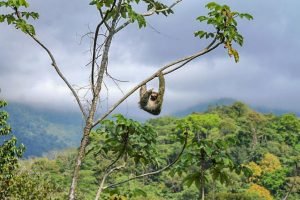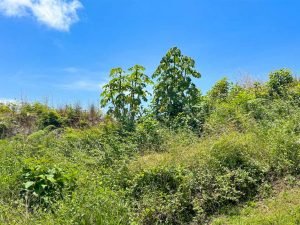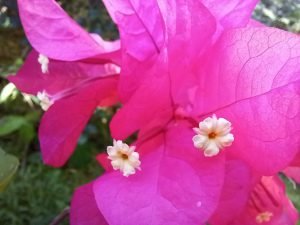Cecropia Tree

This common tree, considered by many to be a ‘just a weed’, is actually a fascinating plant favored by scores of animals such as monkeys, macaws, sloths and toucans – plus it has a very strange symbiotic relationship with Azteca ants, is great at holding back eroding slopes or reforesting cleared areas, and bears a weird fruit that is rarely eaten but in fact considered a sweet treat and a succulent delicacy by man and animal alike. There so much more to this tree than its (well-deserved) reputation as a fast growing weed – read on!


PIONEER SPECIES
We have all seen Cecropias, known as Guarumo in Costa Rica – the tall and lanky trees with very few branches, see-through upper canopies and giant mufti-lobed umbrella-like leaves. They are very noticeable because of their status of ‘pioneer species’ – meaning these trees are among the first large plants to spring up on land that has been cleared by a bulldozer, landslide, flooding, hurricane or fire. If a giant tree falls in the rainforest, it will be the Cecropias that fill in the gap to steal the sunshine. They aggressively outgrow and outcompete all other plants as they race upwards – growing in rich soil, poor soil, sand, or gravel and rocks. Their succulent fruit are favored by many species, and because a single tree can produce 1,000,000 seeds per season, you can imagine how far and wide the seeds are dispersed by hungry animals. So Cecropias have become a very common sight in tropical areas where they proudly and unscrupulously plant themselves wherever they please.
In many areas of tropics and subtropics Cecropias are intentionally planted to re-forest land or as an emergency anti-erosion measure to stabilize slopes and riverbanks. They retain the soil and create new biomass which will then allow other plants to move in. Cecropias grow rapidly to reach a height of 20m or more, with roots that tend to spread out and hold the soil, a perfect choice for soil stabilization; however they live fast and die fast – a typical lifespan of a Cecropia tree is less than 20 years.


THE WEIRD AND TASTY FRUIT
The Cecropia fruit, known as Snake Fingers, Ambaiba, Trumpet Tree Fruit, or Gummy Bear Fruit (amongst many others) is considered an exotic delicacy. The fruit are sweet, tasty, aromatic, juicy, savory and with a jelly-like consistency – thus the ‘Gummy Bear’ reference. They are very high in Vitamins A, Bs, C, and calcium and potassium, as well as antioxidants. The fruit can be eaten raw but it is very common to dry them for later consumption or to use them in the making of jams and marmalades. Owing to their juicy nature, the fruit are rather perishable and should be dried, refrigerated, eaten or made into smoothies or jam with minimal delay following harvest or purchase.
Each flower produces between 1-4 long slender fruit, 10-15 cm in length and 1-2 cm in diameter. When young and unripe, as in the first photo below, the fruit point up. As the mature, they drop and hang down, as seen in the second photo. In tropical settings fruit are produced year-round.


ANIMALS LOVE THE CECROPIA
The sweet, succulent fruit naturally attracts plenty of wildlife. Monkeys, toucans, parrots and macaws, fruit bats, aracaris, possums, countless varieties of birds, and even fish thrive on the fruit and help to spread the tiny Cecropia seeds far and wide. Due to the widespread range and sheers numbers of Cecropia many species of animal depend on the Gummy Bear Fruit as their keystone, or primary, source of food.
Sloths love the Cecropia tree and are often spotted in their branches – and they are easy to spot in a Cecropia as the tree has a very sparse canopy making the sloths stand out like a sore thumb. Sloths feast on the leaves, maybe due to the laziness as one leaf is big enough to keep them busy for a while!

A Howler Monkey in a Cecropia tree.


A SYMBIOTIC RELATIONSHIP WITH ANTS
The Cecropia tree has a very special relationship with Azteca ants – the tree provides the ants with hollow stem areas where they can shelter and nest, as well as sweet liquid food bodies that grow at the bases of the leaves – these are used as high-energy food source by the Azteca. In return, the ants protect the tree from leaf-cutting ant species which can wreak havoc on plants, and they attack any vines or invasive plants from overtaking the Cecropia. Cecropia, being a pioneer specie, is attractive to vines which seek a free ride to sunlight – but these vines can severely harm or even kill the host tree, and they provide pests with easy access to the tree. The Azteca mercilessly chew through any plant that seeks to take advantage of the Cecropia. The ants also patrol the stem and leaves 24/7, attacking any herbivorous insects who dare step onto the leaves, and seek to deliver nasty bites to larger animals like sloths and monkeys.
Interestingly, the Cecropia ‘talks’ to the ants – a freshly damaged leaf releases distress chemicals which alert the ants to potential trouble – this causes scores of ants to emerge form the hollow stem, make their way to the damaged leaf and frantically search for the perpetrator.
And one last amazing fact – the Cecropia is covered with fine hair which work together with hooks on the legs of an ant – this allows the ants to anchor onto the Cecropia to give them leverage when fighting larger invasive insects.
AN INVASIVE ALIEN
One specie of Cecropia is considered to be one of the top 100 invasive alien species in the world. Cecropia peltata, which grows in our area, is wreaking havoc in Africa where it is displacing a very similar but not closely related tree known as Parasolier or African Corkwood Tree. The Parasolier is a very similar tree in looks and habits, also being a prolific pioneer specie, but it seems that Cecropia can outwit the outwitter.


USES OF CECROPIA TREE
Cecropia wood is very similar to Balsa wood – very lightweight, and not very strong – typical of very fast growing trees. It is used to make matchsticks, cheap boxes, lightweight lumber materials and musical instruments like guitars and flutes – in fact another name for a Cecropia is ‘Trumpet Tree’ as the hollow branches have been, and are, being used by native peoples all over Cecropia’s range to make wind instruments similar to flutes and trumpets.
The leaves of a Cecropia have been used to make tea which is said to stimulate the cardiac system, treat asthma and pneumonia, treat diabetes, and also acts as a diuretic. The tea has also been used to treat snake bites. Leaf powder is used to help control Parkinson’s disease.
Root extracts are said to help heal wounds and improve eczema.
Note that the mention of the above medical uses of Cecropia is not medical advice and you should always consult a Doctor before self-medicating or exploring natural or unverified medical treatments…especially if you have been bitten by a snake!
HOPE YOU WILL NEVER LOOK AT CECROPIA THE SAME WAY AGAIN!
Have I convinced you that the Cecropia tree is much more than ‘just a weed’? It is a plant that fascinates on multiple fronts – next time I see one, I will have a closer look as I attempt to spot the Azteca defenders, or perhaps I will give the tree a shake in hopes of scoring a bunch or two of the Gummy Bear Fruit!
Photos #4,6,9,10 courtesy of Wikicommons.

